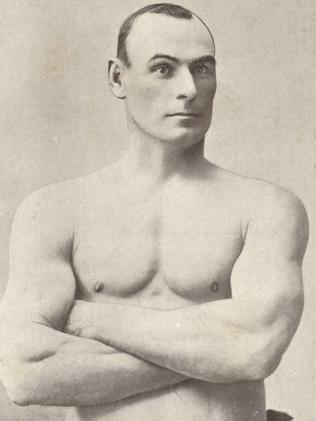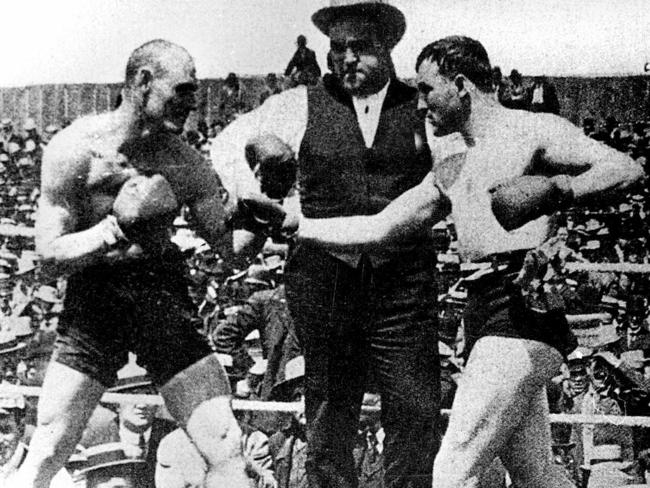THE Australian boxing promoter and rugby league patron Hugh D. McIntosh was such a hustler that he once tried to seduce Rudolph Valentino’s bisexual wife with a ring souvenired from the tomb of Tutankhamen.
Mrs Valentino, the exotic and amorous Natacha Rambova, was a keen Egyptologist but McIntosh — a notorious womaniser known around the world by his nickname “Huge Deal’’ - failed to make it to first base with her despite his lavish gift
For a long time he fared much better in the sporting and business world.
Starting out as a pie-delivery boy, during his extraordinary life he was a miner, doctor’s assistant, train driver, bouncer, cow-milking champion, theatrical entrepreneur, rabbit breeder, milk-bar giant and much more besides.
He raced cars and pushbikes, supported Australia’s Olympic athletes, was the first major sponsor of the fledgling Sydney rugby league competition and a consummate spruiker.
By his early 30s, he was one of Australia’s richest men. He owned one of the grandest homes overlooking Sydney Harbour and leased Lord Kitchener’s Broome Park, near Canterbury, England, re-laying the cricket pitch there with black soil from Bulli.
A member of the New South Wales Upper House, he boasted of friendships with Winston Churchill, Teddy Roosevelt and William Rockefeller. He owned influential newspapers in Sydney and once sacked Kerry Packer’s grandfather, Robert Clyde Packer, as editor of The Sunday Times.


In 1899, McIntosh took over a North Sydney catering company, supplying pies to racetracks and prizefights. It made a fortune.
In 1908, 16,000 American sailors were due to arrive in Sydney with America’s Great White Fleet on a world tour to show off that country’s naval might. The prospect prompted McIntosh, then aged 31, to take an audacious gamble: he wanted to promote a world heavyweight title fight with Australia’s top-gun fighter `Boshter’ Bill Squires, a bush brawler with a huge punch.
Squires was regarded as the hardest punching boxer in the world and the first Australian to fight for the world heavyweight title.
Although his first crack at the world title in 1907 was a shocker, McIntosh believed he still had a chance at the title fighting at home.
When asked the secret of his punching power Squires replied: `I just ‘its ‘em.’
On the back of 19 wins, all by knockout, Squires, a Narrabri railway navvy had travelled to the small seaside town of Colma, California — at the time a major international boxing venue — to fight the new world heavyweight champion Tommy Burns in 1907.
Burns was a short, stocky Canadian whose birth name was Noah Brusso and whose portrait reminded many of Napoleon. Squires was managed by the Melbourne gambler John Wren who could see his fighter’s power translating into glory and huge purses.
Burns had succeeded Jim Jeffries — conqueror of the Australian-trained Peter Jackson and Bob Fitzsimmons — as world heavyweight champion. Giving his stamp of approval to the new titleholder, the massive Jeffries, all 150kg of him, would referee the Burns — Squires fight in Colma on the Fourth of July, 1907.

Both men were around 82kg but the 179cm Squires had height and reach advantages over the squat 170cm Burns and, by all reports, was a much heavier hitter. He was a 10/9 favourite with the bookies and he was full of confidence.
`Boshter’ Bill was the son of `One Eye’ Bill Squires and was born at Edgeroi Station near Narrabri in 1879.
His first prizefight was a third round knockout of Bill Costello in Goondiwindi in 1900. Two years later in Melbourne he beat the Guyana-born veteran Edward ``Starlight’’ Rollins, a vastly more experienced boxer who had been in the ring with some of Australia’s best, including Bob Fitzsimmons, a former world champ.
In Newcastle, Squires manhandled another West Indian fighter Peter Felix, a former Australian champ, but in Sydney lost for the first time by disqualification against Arthur Cripps.
Over the next two years Squires scored a series of quick KOs to catapult him onto the world stage. Ten thousand saw him knock out Tim Murphy at Melbourne’s Exhibition Hall for the Australian heavyweight title and 15,000 defied the rain at Wren’s Ascot racecourse to see him plaster Peter Kling on the morning of the 1906 Melbourne Cup.
When asked the secret of his punching power Squires replied: `I just ‘its ‘em.’
The world title fight with Tommy Burns in Colma was set for 45 rounds. It lasted less than one. Never a master of defence, Squires found out painfully that his brawling tactics were no match for the skills of the little world Canadian champ.

Squires charged out of his corner at the first bell throwing haymakers and as Burns said after the fight: ``Squires wanted to eat me right up.’’ But the Australian’s reputation was too good to be true: his threadbare defence was exposed almost immediately.
The first time Squires hit Burns, the champion grabbed him in a clinch and whispered in his ear: ``Say, Squires, can’t you fight or won’t you?’’
Rattled, Boshter Bill became a sitting duck. Burns sidestepped his heaviest punches and hit him with devastating counters.
Burns dropped Squires three times before Squires was counted out in the opening round after taking a massive straight right to the chin.
``In two minutes and eight seconds’, The San Francisco Examiner reported, ‘the pride of Australia was flat on his back blinking his eyes at the sun. Squires has a glass jaw and no fighter is stronger than his weakest point.’’
The first time Squires hit Burns, the champion grabbed him in a clinch and whispered in his ear: ``Say, Squires, can’t you fight or won’t you?’’
Squires never really recovered from the loss. He would fight 11 more times and suffer 10 more knockouts. He lost two more fights in California, but still believed he could win the championship.
In Dublin, he stopped flabby Irishman Jem Roche in four rounds. He then faced Burns in a rematch at the Neuilly Bowling Palace in Paris on June 13, 1908.
This time, Squires gave Burns hell. The correspondent for London’s Daily Telegraph reported that Burns was saved by the bell in Round 4, with only the world champion’s ``wonderful capacity for taking punishment’’ allowing him to survive a ``terrific punch to the jaw which would have knocked any ordinary man out’’.
Burns’ manager admitted he was ``sick with apprehension’’, but Burns recovered to knock Squires unconscious in the eighth round. It was ``10 minutes before Bill opened his eyes.’’ Seeing his opportunity to make some fast money, Huge Deal McIntosh decided to give Squires a fighting chance at home.

He lured Burns to Australia with a purse of £2,000 — the equivalent of about $A1.5 million today — win, lose or draw. Squires was guaranteed £400, but the bumper crowd would eventually earn him an extra £150 bonus.
Encouraged by Sydney’s Daily Telegraph boxing writer George Wynne, McIntosh contracted a timber merchant to hastily erect an open-air stadium on an old Chinese market garden at Rushcutters Bay. McIntosh named the largest purpose-built boxing arena in the world Sydney Stadium. It would have a roof fitted in 1912 and, as the Old Tin Shed, became the home of Australian boxing for six decades.
Burns was the guest referee for the first ever fight there, on August 21, 1908, when 2,000 people watched Sid Russell outpoint Peter Felix for the New South Wales heavyweight title.
When Squires finally got up, still dazed, he started throwing punches at imaginary opponents.
Just three days later, Burns was the main event defending his world heavyweight title against Squires in brilliant sunshine just after midday on a Monday afternoon.
A record Australian crowd of 16,000 — including many members of the government — hoping to see Squires finally claim the championship belt contributed to a gate of £13,400. They were to be sorely disappointed, even though, Burns, this time a 5/1 favourite, came into the ring with a heavy cold. Winning the toss, Burns chose to start the bout with his back to the sun. He paced himself. Squires made a lively start and, cheered by the huge crowd, had Burns groggy in Round 7.
After 10 rounds, both men’s faces had been bloodied, but Squires was in front. In Round 11, Burns, despite having a blackened eye and a cut face, began to change the complexion of the contest. He looked a new man. He dropped Squires twice in Round 13, the second time for the count from referee Harry Nathan.
When Squires finally got up, still dazed, he started throwing punches at imaginary opponents.

Burns left the stadium in his motor car to plan his next title defence in Melbourne against Richmond Australian rules fullback Bill Lang.
McIntosh went home to plan the most important sporting event the world had seen.
Although Burns had been world champion for two years, he had an enormous shadow hanging over him. Many in the sport believed the best boxer in the world was, instead, a black Texan: Jack Johnson, the son of former slaves.
Two decades earlier, John L. Sullivan had refused to fight Australian-based West Indian Peter Jackson. The colour line had been in force ever since. No black man had ever fought for the world heavyweight championship.
McIntosh wanted to break the embargo, not because he believed in racial equality — far from it — but with an eye to the massive profit that a legally sanctioned ‘race war’ could generate. Burns wanted nothing to do with it, but, after the champ retained his title against Bill Lang, McIntosh made him an offer he couldn’t refuse: £6,000.
Johnson beat Burns easily and became the first black man to hold what was then regarded as the greatest prize in world sport.
Bill Squires fought on until 1916 but his last five fights all resulted in knockout defeats. In later years he became an ardent supporter of the Newcastle middleweight Dave Sands who was top of the world ratings in the early ‘50s.
Huge Deal McIntosh lost his fortune trying to start a chain of milk bars in England and died broke in 1942.
Grantlee Kieza is the author of Boxing in Australia, published by the National Library.

Add your comment to this story
To join the conversation, please log in. Don't have an account? Register
Join the conversation, you are commenting as Logout
Here’s what you can expect with today’s Parramatta weather
As winter sets in what can locals expect today? We have the latest word from the Weather Bureau.
Here’s what you can expect with tomorrow’s Parramatta weather
As winter sets in what can locals expect tomorrow? We have the latest word from the Weather Bureau.